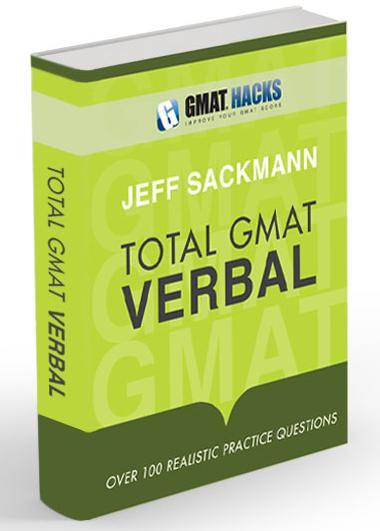
Bookshelf
|
|
Total GMAT Math Jeff's complete Quant guide, on sale now! |
|
|
Total GMAT Verbal Everything you need to ace GMAT Verbal! |
1,800 Practice Math Questions
Buy Jeff's books at Amazon.com

GMAT Official Guide, with IR
OG Math | OG Verbal
OG12 & Quant Rev solutions!
GMAT Question of the Day
Beginner's Guide to the GMAT
GMAT Hacks Affiliate Program

Recent Hacks

Categories
- General Study Tips
- Goals and Planning
- CAT Strategy
- The Mental Game
- GMAT Math Strategy
- GMAT Math Topics
- Mental Math
- Data Sufficiency
- Critical Reasoning
- Reading Comprehension
- Sentence Correction
- Analytical Writing Assessment
- Integrated Reasoning
- IR Explained
- Business School Admissions
- GMAT Prep Resources
- Practice Questions
- Total GMAT Math
- Total GMAT Verbal
- GMAT 111

The Important Parts of GMAT RC Passages
| You should follow me on Twitter. While you're at it, take a moment to subscribe to GMAT Hacks via RSS or Email. |
Many GMAT students have a difficult time handling Reading Comprehension passages in a reasonable amount of time. By my standard, you should be reading passages in 3-4 minutes, which doesn't include the time it takes to answer the associated questions. Most passages aren't very long and should be manageable in that amount of time, but the problem remains.
Many people with this issue ask me how to skim passages. I don't think that skimming (or worse, skipping parts) is the answer, but you can read more efficiently. The biggest problem is often having to repeatedly re-read the passage. If you only read the passage once, carefully, the time limitations should be easy to meet.
Finding the Key Sentences
That said, some parts of a GMAT RC passage are more important that others. While you should read every word, certain sentences are worthy of more attention than others.
While working with a student recently, I developed a short-hand way of looking at this subject. Many GMAT passages are structured in one of a small number of ways. Many contain exactly three paragraphs--an introduction, followed by two supporting points, or two different positions, or an exposition of a topic.
Obviously not every sentence is of equal importance. Let's say that typical three-paragraph passage has four sentences per paragraph. I'll denote the most important sentences with an "A," sentences of moderate importance with a "B," and those of the least importance with a "C."
- P1: Sentence 1: A
- P1: Sentence 2: B
- P1: Sentence 3: B
- P1: Sentence 4: A
- P2: Sentence 1: A
- P2: Sentence 2: C
- P2: Sentence 3: C
- P2: Sentence 4: B
- P3: Sentence 1: A
- P3: Sentence 2: C
- P3: Sentence 3: C
- P3: Sentence 4: B
Topic Sentences and Summaries
As you can probably tell from the ratings, the most important sentences are at the beginning and end of each sentence. Often, you can determine the structure of a passage simply by reading the first sentence of each paragraph. That's a great start, but the final sentence sometimes contains stronger hints regarding the author's position, and that's something the GMAT loves to test.
Once again, you shouldn't skip the "C"-rated sentences, but you shouldn't spend much time on them, either. Especially on topics that are opaque to you (such as science passages), it's easy to get bogged down in the details--but it isn't worth the time to make the effort to fully understand them.
Applying This To Other Structures
Not every passage has three paragraphs of four sentences each! For instance, some GMAT RC passages have just one long paragraph. Here are some general rules:
- The first sentence is always very important.
- The first sentence of each paragraph is also key, especially for understanding structure.
- The last sentence of each paragraph--especially the first--is crucial, especially for understanding the author's viewpoint.
- No matter what the structure, there will always be examples and minor details. They are more likely to come near the end of the passage, and they are always rated "C."
Like all Reading Comprehension techniques, this takes some time to incorporate into your plan of attack. It may slow you down when you first try it, but that isn't a reason to discard it immediately. Once you've used it on 10-12 passages, you should find that it gives you the confidence you need to read through the passage without spending too much time on the details that aren't worth the effort.
About the author: Jeff Sackmann has written many GMAT preparation books, including the popular Total GMAT Math, Total GMAT Verbal, and GMAT 111. He has also created explanations for problems in The Official Guide, as well as 1,800 practice GMAT math questions.
 |
Total GMAT Verbal
The comprehensive guide to the GMAT Verbal section. Recognize, dissect, and master every question type
you'll face on the test. Everything you need, all in one place, including 100+ realistic practice questions. |